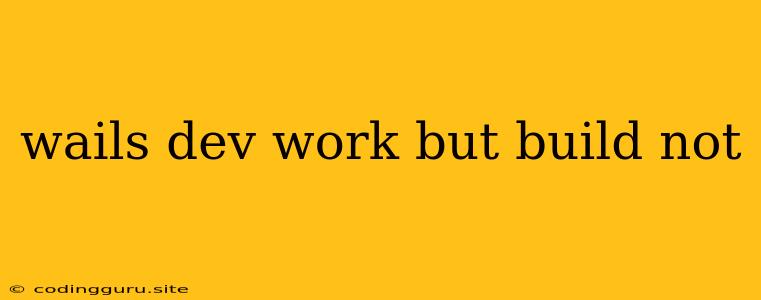The Frustrating "Wails Dev Works But Build Not" Enigma: A Guide to Debugging and Solutions
It's a common frustration among Wails developers: your application runs flawlessly in development mode, but the moment you try to build it, you're greeted with errors. This seemingly innocuous "Wails dev works but build not" problem can be a real headache, but it's not an insurmountable one. This article aims to equip you with the knowledge to tackle this issue and ensure your Wails application builds successfully.
Understanding the Differences:
The first step is understanding why a Wails application might work flawlessly in development but not in production. The key lies in the fundamental differences between these two modes:
- Development Mode: Here, Wails uses a live-reload mechanism to instantly reflect code changes in your browser. This allows for rapid prototyping and development, but it comes with a trade-off: dependencies are often loaded from your local machine rather than being bundled into the final application.
- Production Mode: When building your Wails application for production, the entire application is packaged into a standalone executable. This packaging process must include all necessary dependencies and configurations to ensure smooth operation on target systems.
Common Culprits:
Knowing the differences between development and production modes helps us pinpoint the potential culprits behind the "Wails dev works but build not" issue:
-
Missing Dependencies: While your development environment might be equipped with all required dependencies, they may not be properly included in your production build. This can happen due to:
- Incomplete build configurations: Make sure your Wails build configuration (usually found in your
wails.jsonfile) explicitly lists all necessary dependencies, including their versions. - Dependency Management Issues: If you're using a package manager like
npmoryarn, ensure your dependencies are correctly defined in yourpackage.jsonfile and that you are using the appropriate package manager command to build your application.
- Incomplete build configurations: Make sure your Wails build configuration (usually found in your
-
Environment Variables: Some applications rely on specific environment variables to function correctly. During development, these variables might be set locally, but they might be missing during the build process. This can lead to unexpected behavior or errors.
- Ensure your environment variables are properly set: This might involve setting them in your
wails.jsonfile, using a.envfile, or setting them at runtime.
- Ensure your environment variables are properly set: This might involve setting them in your
-
Conflicting Configurations: The development and production environments might have different configurations. For example, the database connection settings could be different for testing and for live production. This can lead to issues during the build process, especially when these configurations are not properly managed.
- Implement separate configurations for development and production: Utilize Wails' built-in mechanisms for environment-specific configurations, or employ third-party libraries for configuration management.
Troubleshooting Steps:
- Verify Build Configuration: Double-check your
wails.jsonfile. Make sure it includes all dependencies and that the configuration options are suitable for production deployment. - Inspect Dependencies: Analyze your
package.jsonfile to verify that all required dependencies are properly defined and that they are compatible with your target platform. - Analyze Build Logs: Carefully review the build logs for any errors or warnings that might provide clues about the problem.
- Simplify Your Project: If you're working on a complex project, try to isolate the problem by creating a minimal example that reproduces the issue.
- Check for Conflicts: Look for any potential conflicts between your development and production configurations, especially in areas like environment variables, database settings, and other platform-specific settings.
Tips for a Smooth Build:
- Start Simple: If you're new to Wails, begin with a basic "Hello World" application to ensure your build environment is set up correctly.
- Use a Consistent Build Process: Establish a clear and reproducible build process to minimize errors and ensure that your application builds consistently.
- Utilize Dependencies Effectively: Carefully select and manage dependencies to avoid unnecessary bloat and potential compatibility issues.
- Test Thoroughly: Always thoroughly test your application in both development and production environments to catch errors early on.
Example Scenario:
Let's say you're building a simple Wails application that uses a local SQLite database. During development, it works perfectly because the database is readily available. However, when you try to build your application, you get an error because the database is not included in the final executable.
Solution: You would need to explicitly include the SQLite library in your Wails build configuration (within your wails.json) and potentially specify the database file path in your application logic. This ensures that the SQLite library is packaged with your application and the database file is accessible during runtime.
Conclusion:
The "Wails dev works but build not" problem can be frustrating, but with a systematic approach to debugging and a clear understanding of the differences between development and production environments, you can overcome this hurdle. Remember to pay close attention to your build configurations, manage dependencies effectively, and test thoroughly in both environments. By following these guidelines, you'll be well on your way to building and deploying successful Wails applications.
